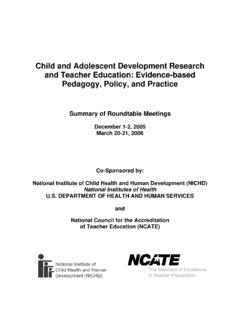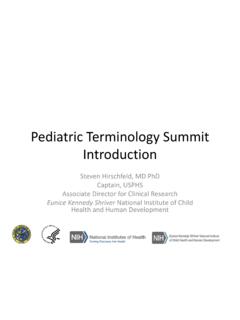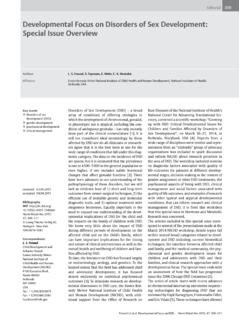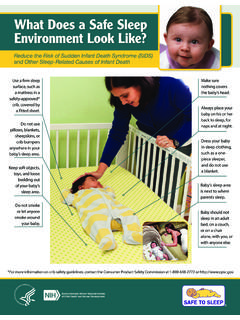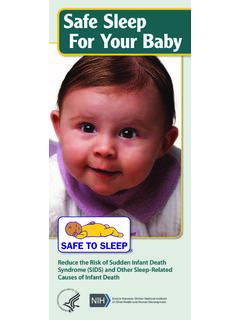Transcription of Findings for Children up to Age 4½ Years
1 PLEASE NOTE: This information was current at the time the document was published in 2006. The information is not being updated and may no longer be accurate. It is provided for historical purposes only. Findings for Children up to Age 4 Years Department of HealtH anD HUman ServiceS. National Institutes of Health national institute of child Health and Human Development PLEASE NOTE: This information was current at the time the document was published in 2006. The information is not being updated and may no longer be accurate. It is provided for historical purposes only. PLEASE NOTE: This information was current at the time the document was published in 2006. The information is not being updated and may no longer be accurate. It is provided for historical purposes only. Dear fellow parents, raising Children is one of the hardest, but most important and rewarding things we do.
2 The daily task of caring for Children can be a challenging job in and of itself. Selecting persons and situations for child care can be even more difficult. child care is now a fact of life for many american families, and many parents now use child care from their child's infancy through kindergarten. more than 10 Years ago, the national institute of child Health and Human Development (nicHD) launched the nicHD Study of early child care and Youth Development (SeccYD) to investigate the relationships between child care and Children 's development. the study examines how differences among families, Children , and child care features are linked to the intellectual, social, and emotional development and health of Children . the study is about more than child care; it describes Children 's lives and development.
3 This booklet is for all parents: for those whose Children are in child care on a full- or part-time basis, for those parents considering child care, and for parents whose Children are not in any non-parental child care arrangement. We hope that this booklet will inform some of your decisions about child care and help you understand your child's development. We will continue to study the complex relationships among child care, families, and Children and to make these results available to you as they are known. Sincerely yours, Alan E. Guttmacher, Director, NICHD. PLEASE NOTE: This information was current at the time the document was published in 2006. The information is not being updated and may no longer be accurate. It is provided for historical purposes only. PLEASE NOTE: This information was current at the time the document was published in 2006.
4 The information is not being updated and may no longer be accurate. It is provided for historical purposes only. Table of Contents Major Findings from the Study ..1. The NICHD Study of Early Child Care and Youth Development (SECCYD) ..2. What are the goals of the NICHD Study? ..2. How was the NICHD Study conducted? ..3. What is child care? ..4. What did the NICHD Study measure? ..4. What aspects of child development did the NICHD Study measure? ..6. An explanation of terms ..7. Causes or Associations? ..7. What Is the Nature of the NICHD Study Findings ?..7. NICHD SECCYD Findings Child Care Quality ..8. What is quality child care? ..8. Regulable Features ..8. Process Features ..10. How are regulable and process features of child care quality related to each other?.
5 12. How is quality of child care related to Children 's development? ..12. Child Care Quality and Cognitive and Language Development Child Care Quality and Social Development Outcomes ..13. Child Care Quality and Health How can parents and caregivers evaluate the quality of child care? ..14. Can quality of child care help Children from families at risk? ..15. NICHD SECCYD Findings Quantity of Child Care ..16. What is quantity of child care? ..16. How is quantity of child care related to Children 's development? ..16. Child Care Quantity and Cognitive and Language Development Child Care Quantity and Social Development Child Care Quantity and Health . PLEASE NOTE: This information was current at the time the document was published in 2006. The information is not being updated and may no longer be accurate.
6 It is provided for historical purposes only. PLEASE NOTE: This information was current at the time the document was published in 2006. The information is not being updated and may no longer be accurate. It is provided for historical purposes only. NICHD SECCYD Findings Child Care Type ..18. What is child care type? ..19. How is child care type related to Children 's development? ..20. Child Care Type and Cognitive and Language Development Outcomes ..20. Child Care Type and Social Development Outcomes ..21. Child Care Type and Health Outcomes ..21. NICHD SECCYD Findings Family Features ..22. What are family features? ..22. How are family features related to Children 's development?..23. Family Features and Cognitive and Language Development and Social Other Findings About Family Features.
7 25. The NICHD Study Beyond Infancy, Early Childhood, and Preschool ..26. Information Where Can I Go for More Information? ..28. National Institute of Child Health and Human Development (NICHD)..28. NICHD Study of Early Child Care and Youth Development (SECCYD) ..29. Administration for Children and Families (ACF)..29. Appendix A About the Families and the Sites Involved in the NICHD SECCYD ..30. Appendix B Child, Family, and Home Features Measured in the NICHD SECCYD ..34. Appendix C The Positive Caregiving Checklist ..36. Appendix D Guiding the Study ..39. Appendix E . PLEASE NOTE: This information was current at the time the document was published in 2006. The information is not being updated and may no longer be accurate. It is provided for historical purposes only.
8 PLEASE NOTE: This information was current at the time the document was published in 2006. The information is not being updated and may no longer be accurate. It is provided for historical purposes only. Major Findings Children who were cared for exclusively by their mothers did not develop differently than those who were also cared for by others. Children in higher quality non-maternal child care had somewhat better language and cognitive development during the first 4 Years of life. they were also somewhat more cooperative than those who experienced lower quality care during the first 3 Years of life. Children with higher quantity (total combined number of hours) of experience in non-maternal child care showed somewhat more behavior problems in child care and in kindergarten classrooms than those who had experienced fewer hours.
9 In the early 1990s, the majority of Children began Children who attended child care centers had somewhat some non-maternal care by 6 months of age. results better cognitive and language development, but also from the nicHD Study of early child care and Youth showed somewhat more behavior problems in child Development show that, in its demographically and care and in kindergarten classrooms than Children who ethnically diverse sample of more than 1,000 Children , experienced other non-maternal child care arrangements. the average child spent 27 hours a week in non-maternal care over the first 4 Years of life. During the Children 's parent and family characteristics were more strongly first 2 Years of life, most child care took place in family linked to child development than were child care homes with relatives or in child care homes; as Children features.
10 And, parent and family characteristics got older, more were in center-based care. predicted some developmental outcomes that were not predicted by child care. for instance, Children showed When it came to understanding how these experiences more cognitive, language, and social competence might influence Children , knowing simply whether a child and more harmonious relationships with parents when was or was not ever in non-maternal care provided little parents were more educated, had higher incomes, and insight into a child's development. Children who were provided home environments that were emotionally cared for exclusively by their mothers did not develop supportive and cognitively enriched, and when mothers differently than those who were also cared for by others.
